SBS Transit Volvo B9TL (Euro V) – Wright Eclipse Gemini II bodywork [Overview]
The Volvo B9TL Wright is the most common double-decker bus model in Singapore. With over a thousand units on the road, these omnipresent buses with their rounded front appearance have become ubiquitous sight. These buses were introduced into service in different batches.
Here, we lay down the differences between each batch for the subsequent article.
| Batch | Specs | Units | Description | Remarks |
| 1 | 150 buses
Low Entry ZF Ecolife |
150 | SBS7500D – SBS7686B (with unused registrations numbers) |
|
| 2 | 300 buses
Low Entry / Low Floor Voith DIWA |
30 | SBS7700T – SBS7729L | Low Entry |
| 240 | SBS3000G – SBS3238M, SBS3269Z | Low Floor | ||
| 30 | SBS3300R – SBS3329J | Low Floor Purchased under BSEP |
||
| 3 | 565 buses
Low Floor Voith DIWA |
446 | SBS3240E – SBS3268B, SBS3270T – SBS3299L, SBS3600A – SBS3986L | Ownership of SBS3968P, SBS3970P, SBS3973Z, SBS3975T – SBS3986L transferred to LTA prior to full transition to Bus Contracting Model |
| 119 | SBS3330D – SBS3448Z | Purchased under BSEP | ||
| 4 | 415 buses
Low Floor ZF Ecolife |
23 | SBS1Z – SBS23K | Ownership transferred to LTA prior to full transition to Bus Contracting Model |
| 71 | SBS3449X – SBS3482Z, SBS3487K – SBS3523P | Purchased under BSEP | ||
| 321 | SG5176G – SG5185E SG5300P – SG5610U |
Ownership transferred to LTA prior to registration Registered under Bus Contracting Model prior to full transition |
||
| 176 Buses Low Floor ZF Ecolife |
176 | SG5000E – SG5175J | Additional order purchased under Bus Contracting Model |
Construction
Just like the Euro III Volvo B9TL (CDGE) buses, SBS Transit undertook the task of assembling these buses locally from the chassis up. Bodywork components in complete knock-down (CKD) form was shipped from Wrightbus, based in Ballymena, Northern Ireland. At the bus assembly facility in Hougang Depot run by Comfort DelGro Engineering (SBS Transit’s technical counterpart), buses are assembled and tested before being registered and put into service island-wide.
Technical Specifications
Many Volvo B9TL Wright buses share similar technical specifications. Here’s a table at a glance:
| Batch 1 | Batch 2A | Batch 2B | Batch 3 | Batch 4 | |
| Quantity | 150 | 30 | 270 | 565 | 591 |
| Registered | Sep 2010 – Aug 2011 | Sep 2011 – Dec 2012 | Jan 2013 – Jun 2015 | Aug 2015 – Dec 2017 | |
| Technical Specifications | |||||
| Engine | Volvo D9B310 EC06B engine, 9.4-litre Power/torque rating of 310 hp (228 kW) @ 1900 rpm / 1400 Nm @ 1100 – 1500 rpm |
||||
| Emissions control | Euro V compliant Selective Catalytic Reduction (SCR) technology requiring diesel exhaust fluids such as AdBlue. |
||||
| Transmission | ZF EcoLife 6 AP 1410 B | Voith DIWA 864.5 | ZF EcoLife 6 AP 1403 B | ||
| Entry | Low Entry | Fully Low Floor | |||
| Capacity | Seating (Upper deck): 55 Seating (Lower deck): 27 Standing: 49 Total: 131 (With 1 Wheelchair bay) |
Seating (Upper deck): 55 Seating (Lower deck): 27 Standing: 51 Total: 133 (With 1 Wheelchair bay) |
U55 + L27 + S53 Total: 135 (With 1 Wheelchair bay) |
||
| Electronic Display Signage | Hanover | LECIP | LECIP & Hanover | LECIP | |
While all Volvo B9TL Wright buses are aesthetically similar, there are three different interior layouts across the fleet. The first variant is a Low Entry cabin, offering step-free access between the entry and exit door only. A single step separates the rear door area and lower deck seating area which has predominantly aisle-facing seats. Batch 1 and 2A buses use this configuration.
The second variant is a fully Low Floor cabin, offering step-free access right until the last row of seats on the lower deck, improving accessibility as compared to the first variant. Part of the aisle-facing seats has been converted to front-facing seats located just behind the rear door and wheelchair bay. Batch 2B and 3 buses use this configuration.
The third variant is similar to the second variant in lower deck layout, but incorporates straight stairs with two staircase landings instead of the curved stairs in previous variants. The priority seats located between the entry and exit doors are also equipped with headrests. Batch 4 buses use this configuration.
Features common to all Volvo B9TL Wright buses are:
- Selective Catalytic Reduction (SCR) technology requiring diesel exhaust fluids such as AdBlue.
- Volvo Electronic Braking System (EBS5), Anti-Lock Braking System (ABS) and Traction Control System (TCS)
- Brakes engage when doors are open, throttle interlock prevents bus movement with doors open
- Electronically-controlled air suspension
- Eberspächer Sütrak R 488 air conditioning units specially designed to meet SBS Transit’s requirements
- Rear fan attachment at the bottom left of the engine cover for better cooling
- SMC Transit plug doors (only SBS3921Z equipped with Ventura sliding plug doors)
SBS Transit Volvo B9TL Wright – Batch 1
In August 2009, SBS Transit placed orders for 150 Volvo B9TL chassis as part of a S$87 million fleet renewal programme, This time, they opted for the environmentally friendly Volvo D9B310 engine, which met stringent Euro V emission standards. They were to be built with the Wright Eclipse Gemini II (WEG2) bodywork produced by Wrightbus of Northern Ireland.
The Volvo B9TL Wright had previously been popular with bus operators in Hong Kong and the United Kingdom, with a good reputation for reliability and compliance with emission standards. The buses would be registered between 13 Sep 2010 to 26 Aug 2011, using the registration numbers SBS7500D – SBS7686B, excluding registration numbers containing the number “4” in the third and fourth digit.
Prototype Unit (SBS7500D)
SBS7500D, the Volvo B9TL Wright prototype, was assembled by Wrightbus in Northern Ireland and shipped completely-built-up (CBU) to Singapore, where it was used as a reference unit for the local assembly of other WEG2 kits.
With Hong Kong bus operators being major customers of the Volvo B9TL Wright, minor Hong Kong specifications were carried over to the SBST prototype, intentionally or by accident:
- Tree guards (removed prior to entering revenue service)
- Opaque sticker was placed over the upper deck window, where a TV screen would have been installed
- Rectangular depression was cut out at the rear, where Hong Kong buses would have fixed their registration plates
- Plain grey interior flooring differs from other local B9TL Wrights
- Additional tail light mounting holes at the rear (unused)
Several years after introduction, SBS Transit fashioned a metal plate to cover up the depression at the rear of the bus. Minor differences aside, technical specifications of SBS7500D were identical to the rest of Batch One Volvo B9TL Wrights.
The upper deck windscreen opaque sticker on SBS7500D was removed in late 2017.
Production Batch (SBS7501B – SBS7686B)
The first batch (Batch 1) of Volvo B9TL Wrights were built by Comfort DelGro Engineering (CDGE)’s bus assembly facility in Hougang Depot, which would continue to assemble all future Volvo B9TL buses for SBS Transit.
The first batch of B9TL Wright chassis was low-entry, meaning that the bus offered step-free entry between the front and rear exit doors, with an additional step before the lower deck rear seating area. They were also paired with six-speed ZF EcoLife transmissions; subsequent batches of Volvo B9TLs would all use four-speed Voith DIWAs. Although the ZF offers smoother acceleration and performs better at highway speeds, the Voith offers faster initial pickup and hill-climbing abilities with fewer gear changes (and some say lower service intervals too).
Technical Specifications:
| Volvo B9TL Wright (Batch 1) | |
| Engine | Volvo D9B310 EC06B (SCR) |
| Transmission | ZF EcoLife 6 AP 1410 B (6-speed) |
| Configuration | Low Entry |
| EDS | Hanover |
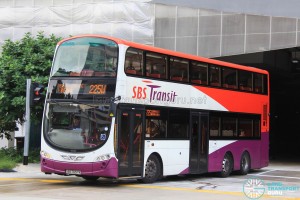
Additional Specifications:
The low-entry Batch 1 Volvo B9TL Wright has a licensed capacity for 131 passengers, comprising 55 upper deck seating, 27 lower deck seating and 49 standing passengers, with a single wheelchair bay.
Many buses were modified with a rear cooling fan on the engine cover to help dissipate heat from the engine.
SBS Transit Volvo B9TL Wright – Batch 2
In August 2009, SBS Transit placed further orders for 300 more Euro V Volvo B9TL chassis, and the similar WEG2 bodywork supplied by Wrightbus. As part of a fleet renewal programme inclusive of 300 Mercedes-Benz Citaros, the orders were valued at S$268 million.
The Batch 2 is unique in that buses were delivered in two different specifications. The first 30 buses were built on low entry chassis (similar to Batch 1), but the orders were changed midway through delivery in favour of the low-floor option, which offered step-less access from front door to rear. The remaining 270 buses were but to low-floor specifications, but all other technical aspects between the low-entry and low-floor buses were similar.
Additionally, SBS Transit opted for a four-speed Voith DIWA transmission over the six-speed ZF EcoLife transmission used for the previous batch of Volvo B9TLs.
Production Batch 2 (Low-Entry specification) (SBS7700T – SBS7729L)
The first 30 buses of the Batch 2 B9TLs were built to similar interior configurations as the Batch 1 buses, and these were registered between 21 Sep 2011 and 30 Dec 2011, using the registration numbers SBS7700T – SBS7729L.
Technical Specifications:
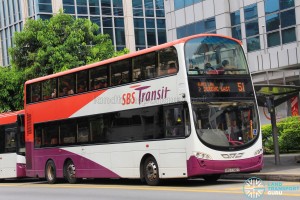
| Volvo B9TL Wright (Batch 2) (Low-Entry) | |
| Engine | Volvo D9B310 EC06B (SCR) |
| Transmission | Voith DIWA 864.5 (4-speed) |
| Configuration | Low Entry |
| EDS | Hanover |
The only technical difference between Batch 1 and Batch 2 Wrights is the Voith DIWA 864.5 gearbox in place of the 6-speed ZF EcoLife 6AP 1410B gearbox. The low-entry chassis meant that there was a step on the lower deck between the exit door and the lower deck seating. After these 30 buses were delivered, all future Volvo B9TLs were of the low-floor version.
Although very similar, the lower deck interior flooring has slight modifications as compared to the Batch 1 to accommodate more equipment. The licensed carrying capacity is similar to that of Batch 1 buses.
Production Batch 2 (Low-Floor specification) (SBS3000G – SBS3238M & SBS3269Z)
The remaining 270 Batch 2 Volvo B9TL buses differed from the first 30 after chassis specifications were changed to a fully-low-floor design, featuring zero-step access from the entrance to the rear row of seats. They bore LECIP Electronic Display Signages (EDS) in place of Hanover units. Technical specifications, however, are exactly identical.
These Batch 2 B9TL Wrights of low-floor specification were registered between 22 Nov 2011 – 28 Dec 2012, using the registration numbers SBS3000G – SBS3238M and SBS3269Z. However midway through deliveries and registration, 30 buses of this batch were reallocated to the then-newly-launched Bus Service Enhancement Programme (BSEP), for deployment on new BSEP routes, as well as the service enhancement of existing routes. BSEP Buses were registered between 13 Sep 2012 and 3 Dec 2012 as SBS3300R – SBS3329J.
Technical Specifications:
| Volvo B9TL Wright (Batch 2) (Low-Floor) | |
| Engine | Volvo D9B310 EC06B (SCR) |
| Transmission | Voith DIWA 864.5 (4-speed) |
| Configuration | Fully Low Floor |
| EDS | LECIP |
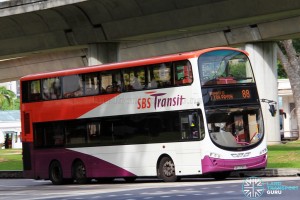
Additional Specifications:
With the new fully-low-floor chassis, the interior configuration was modified. Four of the original aisle-facing seats were converted into two sets of forward facing seats located behind the exit door and wheelchair bay. A LECIP Electronic Display Signage (EDS) replaced Hanover units used on previous batches of buses. Licensed carrying capacity increased from 131 to 133 passengers, comprising 55 upper deck seating, 27 lower deck seating, 51 standing passengers and a single wheelchair bay.
Many buses were modified with a rear cooling fan on the engine cover to help dissipate heat from the engine. SBS3189X was also fitted with a Hanover EDS.
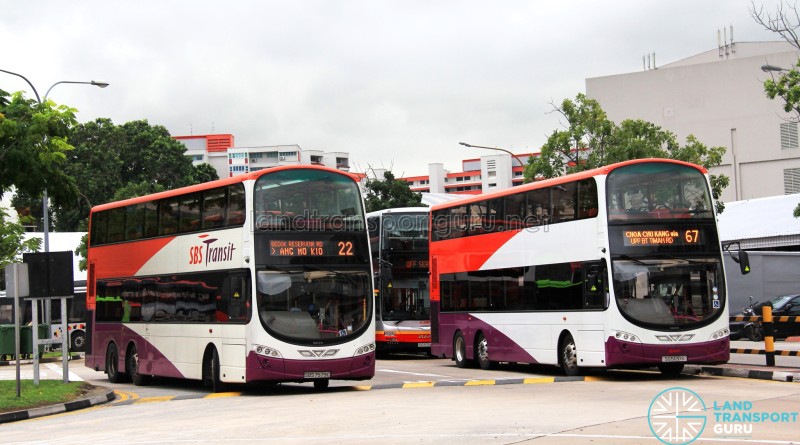
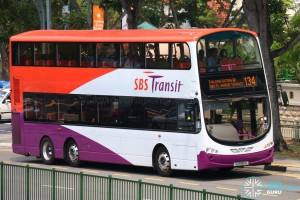
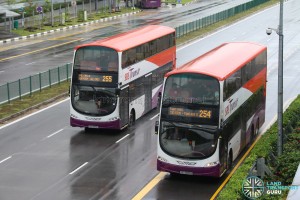
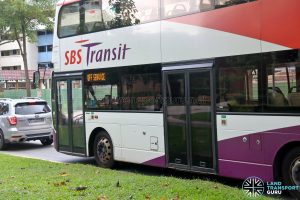

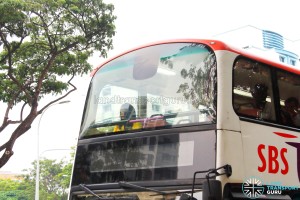
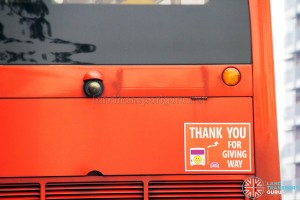
SBS3189X was also the Batch 2 bus with Hanover EDS